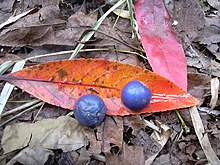
Back عنب أسترالي Arabic عنب استرالى ARZ Ganitri BAN Elaeocarpus angustifolius Catalan Elaeocarpus angustifolius CEB Elaeocarpus angustifolius German Elaeocarpus angustifolius Spanish انجیر آبی Persian Elaeocarpus angustifolius French Ganitri ID
| Elaeocarpus angustifolius | |
|---|---|

| |
| Leaves and fruit on the ground in Keʻanae Arboretum, note this may actually be E. grandis | |
| Scientific classification | |
| Kingdom: | Plantae |
| Clade: | Tracheophytes |
| Clade: | Angiosperms |
| Clade: | Eudicots |
| Clade: | Rosids |
| Order: | Oxalidales |
| Family: | Elaeocarpaceae |
| Genus: | Elaeocarpus |
| Species: | E. angustifolius
|
| Binomial name | |
| Elaeocarpus angustifolius | |
| Synonyms[3] | |
|
List
| |
Elaeocarpus angustifolius is a species of flowering plant in the family Elaeocarpaceae and occurs from India to New Caledonia and northern Australia. Common synonyms are E. ganitrus and E. sphaericus. It is a large evergreen tree, often with buttress roots, and has leaves with wavy serrations, creamy white flowers and more or less spherical bright blue drupe fruit. In English, the tree is known as utrasum bean tree in India.[4] In Sri Lanka recorded names are woodenbegar and Indian bead tree.[5] It is simply known as elaeocarpus in the Northern Territory of Australia.[6] Other names used for this tree in Australia are Indian oil fruit and genitri.[7] In Hawaii it (or the possible synonym E. grandis) is known as a blue marble tree.[8]
In India, the cleaned pits of the fruit of this tree are known as rudraksha in the Hindi language (from Sanskrit: rudrākṣa, meaning "Rudra's teardrops" or "eyes") and are widely used as prayer beads, particularly in Hinduism. Rudraksha might be produced by more than one species of Elaeocarpus, however E. angustifolius is the principal species used in the making of mala (garlands).
- ^ Botanic Gardens Conservation International (BGCI) & IUCN SSC Global Tree Specialist Group (2019). "Elaeocarpus angustifolius". IUCN Red List of Threatened Species. 2019: e.T145371284A145371286. Retrieved 23 January 2023.
- ^ "Elaeocarpus angustifolius". Australian Plant Census. Retrieved 4 February 2021.
- ^ "Elaeocarpus angustifolius". Plants of the World Online. Retrieved 8 January 2022.
- ^ Burkill, Humphrey Morrison (1985). Useful Plants of West Tropical Africa. Vol. 2. Royal Botanic Gardens, Kew.
- ^ Sumanarathne, W.G.A.S.; Ranaweera, L.T.; Weebadde, C.K.; Sooriyapathirana, S.D.S.S. (September 2020). "Assessment of the Morphometric Variation of Fruits and Phylogenetics of Elaeocarpus ganitrus (Woodenbegar) and Elaeocarpus serratus (Ceylon Olive)". The Journal of Agricultural Sciences - Sri Lanka. 15 (3): 362–377. doi:10.4038/jas.v15i3.9028. S2CID 221764111. Retrieved 18 January 2022.
- ^ "Elaeocarpus angustifolius". Northern Territory Government. Retrieved 8 February 2021.
- ^ "Showing Elaeocarpus angustifolius". Vascular Plants - Australian Plant Name Index. Council of Heads of Australasian Herbaria. Retrieved 8 January 2022.
- ^ Woodcock, D. W.; dos Santos, G.; Taylor, D. (January 2000). "The Buttressed Blue Marble Tree: Wood and Growth Characteristics of Elaeocarpus angustifolius (Elaeocarpaceae)". Annals of Botany. 85 (1): 1–6. doi:10.1006/anbo.1999.0985. JSTOR 42770596. S2CID 84567275.
